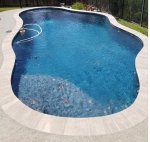So glad to have found these forums and appreciate all the info available to help pool owners!
We put in a 10,000 gallon SWG pool with Pebble Tech finish about 3 years ago (pic attached below post). We are first time pool owners and the builder wasn't great about education and care info. However, the pool has been doing fine, and we thought we had everything under control. We tested the water occasionally, had noticed some flakes a time or two and got some advice and chemicals from the local pool store and that went away. Basically things were okay until recently though we always struggled keeping the chemicals in balance. We've had a lot of rain this spring, the pool has run over a couple times and we've had to adjust the level and add chemicals, etc.
About 4-6 months ago, we noted a few brown-black spots had cropped up. We did some reading online, thought it might be dirt scale, and got especially vigilant about weekly brushing with nylon brush, testing the water, and maintaining the chemicals. This helped a few places, others not so much, and the spots seemed to be multiplying. Based on what we've read the last couple days, including the article here on TFP, we have determined we have black algae
We have the Taylor K-2006-SALT, DPD-FAS test kit but have also been having the pool place test the water to help us ensure we use the kit properly. The pool store’s test as taken today is attached (they said the Free Chlorine was actually 14 but their field only goes up to 9.9). But using our kit, we found the current levels to be:
Free Chlorine: 10.4
Combined Chlorine: 0
PH: Greater than 8
TA: 110
Calcium Hardness: 450
CYA: 40
Salt: 3090
We have not been shocking our pool up to now, as it didn’t seem to need it and we were told that a SWG would help with the need to do shock treatment. From what I read on TFP, we should have been doing that weekly. I think we better understand now too about the Chlorine/CYA ratio, versus targeting them as isolated figures which is what we have been doing (rather unsuccessfully).
Anyway, after reading the black algae page, it appears we need to do the SLAM process, and brush at least twice daily with stainless steel brushes. But the Chlorine/CYA Chart recommends a CYA level above 60. Should we raise the CYA level to 70 before staring the SLAM process? And have we missed any other steps that need to occur before we add the liquid chlorine?
Any advice/thoughts on how to proceed are appreciated, and thank you in advance!!


We put in a 10,000 gallon SWG pool with Pebble Tech finish about 3 years ago (pic attached below post). We are first time pool owners and the builder wasn't great about education and care info. However, the pool has been doing fine, and we thought we had everything under control. We tested the water occasionally, had noticed some flakes a time or two and got some advice and chemicals from the local pool store and that went away. Basically things were okay until recently though we always struggled keeping the chemicals in balance. We've had a lot of rain this spring, the pool has run over a couple times and we've had to adjust the level and add chemicals, etc.
About 4-6 months ago, we noted a few brown-black spots had cropped up. We did some reading online, thought it might be dirt scale, and got especially vigilant about weekly brushing with nylon brush, testing the water, and maintaining the chemicals. This helped a few places, others not so much, and the spots seemed to be multiplying. Based on what we've read the last couple days, including the article here on TFP, we have determined we have black algae
We have the Taylor K-2006-SALT, DPD-FAS test kit but have also been having the pool place test the water to help us ensure we use the kit properly. The pool store’s test as taken today is attached (they said the Free Chlorine was actually 14 but their field only goes up to 9.9). But using our kit, we found the current levels to be:
Free Chlorine: 10.4
Combined Chlorine: 0
PH: Greater than 8
TA: 110
Calcium Hardness: 450
CYA: 40
Salt: 3090
We have not been shocking our pool up to now, as it didn’t seem to need it and we were told that a SWG would help with the need to do shock treatment. From what I read on TFP, we should have been doing that weekly. I think we better understand now too about the Chlorine/CYA ratio, versus targeting them as isolated figures which is what we have been doing (rather unsuccessfully).
Anyway, after reading the black algae page, it appears we need to do the SLAM process, and brush at least twice daily with stainless steel brushes. But the Chlorine/CYA Chart recommends a CYA level above 60. Should we raise the CYA level to 70 before staring the SLAM process? And have we missed any other steps that need to occur before we add the liquid chlorine?
Any advice/thoughts on how to proceed are appreciated, and thank you in advance!!


Last edited:


 If you are convinced the spots you are seeing are from black algae, or any other algae for that matter, then yes - follow the
If you are convinced the spots you are seeing are from black algae, or any other algae for that matter, then yes - follow the